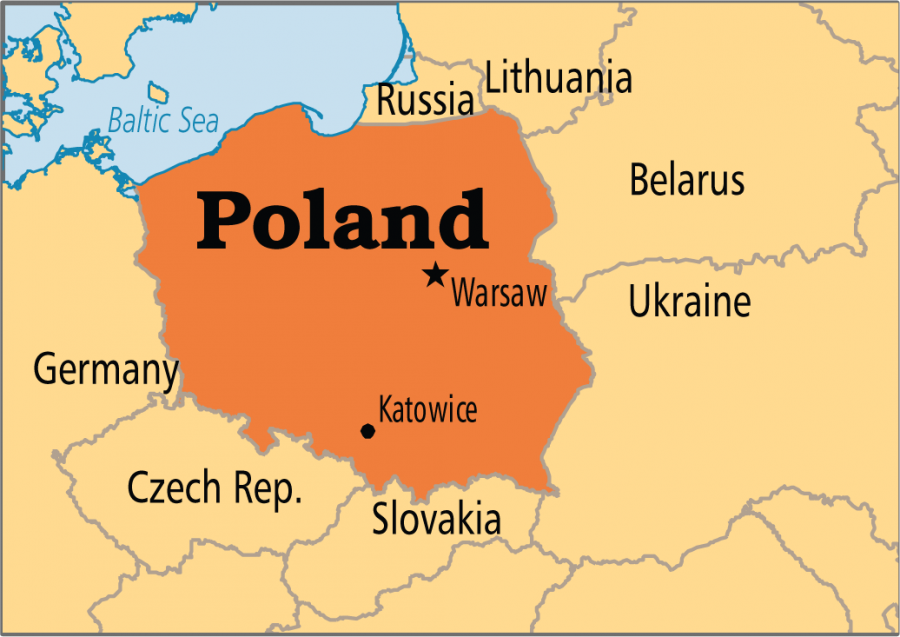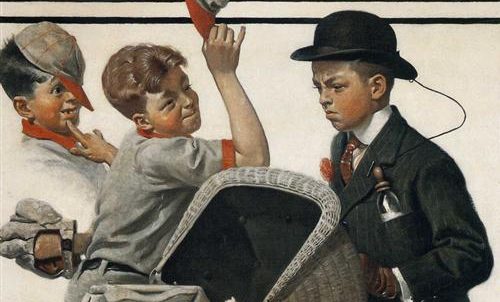The Story of Poland: Pushes, Punishments and Partitions
Poland, a Catholic Slavic Eastern European country, has been occupied or become a subordinate state to another power for 165 years out of the past 300 years. Once a mighty European power, its empire was taken by its enemies.
First, before the period of partitioned Poland, it was a kingdom roughly in the same area as modern day Poland which was baptized in 996. Later it became the Commonwealth of Poland-Lithuania, spanning almost half a million square miles. It was a personal union, which means that two nations were ruled by the same king, making it effectively a single nation. The union was first established in 1385 and re-established in 1569 (Union of Lublin which had the two nations follow the same laws and institutions) and throughout that period it faced hostile neighbors, which would go to great lengths to weaken it.
The Germans, were largely in the loose protective confederation called the Holy Roman Empire, had a thing for Germanizing slavs. The Pomeranians, who were Catholicized, were put into the Holy Roman Empire and gradually assimilated after gaining independence from Poland. They stopped speaking their Slavic language and practicing their Slavic heritage, instead practicing German ones. This was directly west of Poland, and now it and the Holy Roman Empire shared a border The Holy Roman Empire wanted to push east into Poland under the claim from an exiled Polish noble. However, the Poles defeated the Germans at the Battle of Psie Pole, giving Poland some deterrent against the Germans.Czechs were also attempted to be Germanized, but luckily for them they had a strong kingdom, the Kingdom of Bohemia.The kingdom had strong influence inside the Holy Roman Empire after they became an electorate in the Golden Bull decree (1356)- meaning they voted for the next Holy Roman Emperor and those seeking emperorship would likely not anger them. However, Bohemia was still part of the mostly German Holy Roman Empire and bordered Poland through its Bohemian vassal states of the Slavic Silesians. The west was seemingly swarming with Germans, and then they came from the North.
The Teutonic Order, a German crusading order, arrived in northern Poland in Prussia in 1226 to help the Catholic Poles from the “pagan” Baltic tribes of Prussians, Lithuanians and Latvians. While they agreed with the Poles to help, and they did so with Catholicizing/ genociding the Balts. The Order nabbed the important port city of Danzig/Gdansk and the entire province of Pomerelia from Polish hands. This would make the Poles headstrong enemies with the Order, and after several wars which left the Order devastated, the order would become vassals under Poland (Ducal Prussia) and have the remaining lands annexed into Royal Prussia.
Then there were the Russians, who for centuries were divided into bickering kingdoms, which was taken advantage of by Lithuania, and later Poland-Lithuania. This had major east slavic regions and cities controlled by the Commonwealth, including Lviv, Kiev, Minsk, Smolensk and Vitebsk. Out of only need for stability were the local Orthodox peoples allowed to practice their faith, but still the Russians, united by Muscovy, wanted to liberate their Orthodox and east Slavic brethren from what they saw as oppressive Catholic rule.The Russians would fight the Poles for centuries, capturing Smolensk in 1654 and other Russian populated border regions.
While dealing with threats from the West, North and East, Southern threats would emerge from the rising Ottoman empire. The Ottoman empire seized the Marquisate of Moldova, which was Polish, and made it into an Ottoman vassal. The Black Sea coast and other Ukrainian steppe lands were lost to the Ottoman vassal the Crimean Khanate. This threat would become even more dangerous as the Ottomans made a bid to take Vienna, capital of Austria, in 1683. The Poles and Austrian, who were the Holy Roman Emperors and had control of Bohemia and Silesia, which had an unfriendly relationship. If the Muslim Ottomans took on of the most important central European cities, Christian Europe would be in serious danger of being conquered by Muslim forces, including Poland-Lithuania. Knowing this, the Poles,with the famous King Jan Sobieski, used his 3,000 Polish Hussars (elite cavalry units) and 20,000 allied cavalry to launch the largest cavalry charge in history. They rode down a local mountain straight into the backside of the Ottoman positions, effectively destroying the almost 170,000 strong Ottoman army. For saving Austria, the Holy Roman Empire, and likely all of Christian Europe, the Poles were rewarded with punishments and partitions.
With wars withering down, its neighbors began to pick away at the nation. The Teutonic Knights, now secularized, joined in a personal union with Brandenburg, a large Holy Roman Empire electorate, and in 1701, the two entities joined to form the Kingdom of Prussia, and wanted to connect its separated lands (As Brandenburg was separated from East Prussia by Pomerelia, owned by Poland). Russia still eyed to gain control of the former capital of the Kievan Rus’, Kiev and other slavic lands. Austria, didn’t want to be left out of the land grab and let the other two have all the land, so they opted into the 3 Partitions of Poland. The partitions were able to happen due to the sejm. The sejm was made up of wealthy nobles who voted on laws, taxes, troop movements, and voted for who was to be King. All nobles in the sejm were equal, and even if there were a majority, the act of the majority acting against the will of the minority was seen as unequal. This led to the creation of the liberum veto, in which one noble could object to a ruling and it would be ended, even if there was an overwhelming majority supporting the ruling, leading to almost nothing getting passed, just like the U.S. under the Articles of Confederation. The liberum veto was used by Prussia, Russia and Austria as they would bribe a noble to institute liberum veto, making any reforms or progress for the Commonwealth impossible. This also had the consequence that these bribed leaders would only approve of leaders who were supported by the bribers, effectively having Prussia, Russia and Austria pick the king of Poland-Lithuania.
This also led to the end of the Commonwealth, as the appointed kings would approve the partitions. The Poles tried fighting back, but after the Polish-Russian war in 1792, the military was neutralized and its government fully controlled by the three outside powers. After three partitions, the Commonwealth was wiped off the map in 1795. However, Poland would see the light of existence again thanks to the promiscuous narcissist Napoleon, who after defeating Prussia, Austria and Russia in several different Napoleonic Wars, opened the door for a popular uprising allowing French troops to create the Duchy of Warsaw. This was tiny compared to the Commonwealth, and was more western in terms of geography, but it gave hope for the Polish people. This dreamy optimism was destined to be short lived, as Napoleon was too arrogant, had his army freeze to death, which allowed Russia, Prussia and Austria to once again partition a Polish state in 1815. This only left a city state in Krakow. This would again be seized by Austria in 1846 after a Polish uprising took away the city’s independence.
The Polish state would not exist until 1916, in which the German Empire, which was formed by Prussia, offered to “liberate” Poland and take it “under its wing” as a puppet buffer state against Russia. Poland was now pushed eastward, as Germany wouldn’t give up its Polish lands back to Poland. Germans wanted to have the Poles in Germany move away into the puppet state, freeing up lands for German settlement. Then Germany lost WWI, and the Poles in the German Empire rebelled and joined the now free Polish state. The Poles would watch in glee as their enemies, Germany and Austria-Hungary would be themselves partitioned and have some of their populations now be ethnic minorities in someone else’s empire. However, the Poles wanted to make Poland great again, by that they wanted a return to the Commonwealth of Poland-Lithuania. Lithuania declined saying it wanted to try to be independent, so in a polite response Poland seized Lithuania’s ancient capital of Vilnius. After dealing with its marriage problems, Poland wanted to move even more east and invaded the now Soviet Union in order to reclaim Belarusian and Ukrainian lands. The Poles almost did a Napoleon and almost lost to Russia when invading, but then the Russians were badly defeated in the Battle of Warsaw, and Poland got some of the territory it desired. Poland’s safety would last until the rise of Hitler in neighboring Germany.
Hitler wanted many things, including land from Poland to once again connect East Prussia to Germany on land. The Poles of course refused as it would cut them off from the sea and they were tired of losing land. Hitler did what many Germans did before, conspire with a neighbor of Poland to divide its land. This led to Stalin and Hitler signing the Molotov-Ribbentrop Pact which would partition Poland, giving Belarusian and Ukrainian lands to the Soviet Union while giving the rest to Germany. In 1939, Poland would fight bravely, but for a third time would be wiped off the map. The Nazis were defeated, but the Soviet Union, as did Germany earlier, didn’t want to give up that nice Polish land. Therefore, the Soviet Union pushed Poland, geographically west. This led to Germany losing a quite sizable amount of land to make up Poland’s western territory. However, Poland wasn’t free, and would remain a Soviet satellite state for 44 years. Poland now is a free nation, roughly in the spot it was in 1000, moved several miles east, and finally west, to return back to its comfy place. It only took millions of dead and displaced, added with a century and a half of oppression. Poland is a sad story, but also a story of a resilient people, who not without their flaws, had a non-nomadic nation move so much, both physically and socially.












